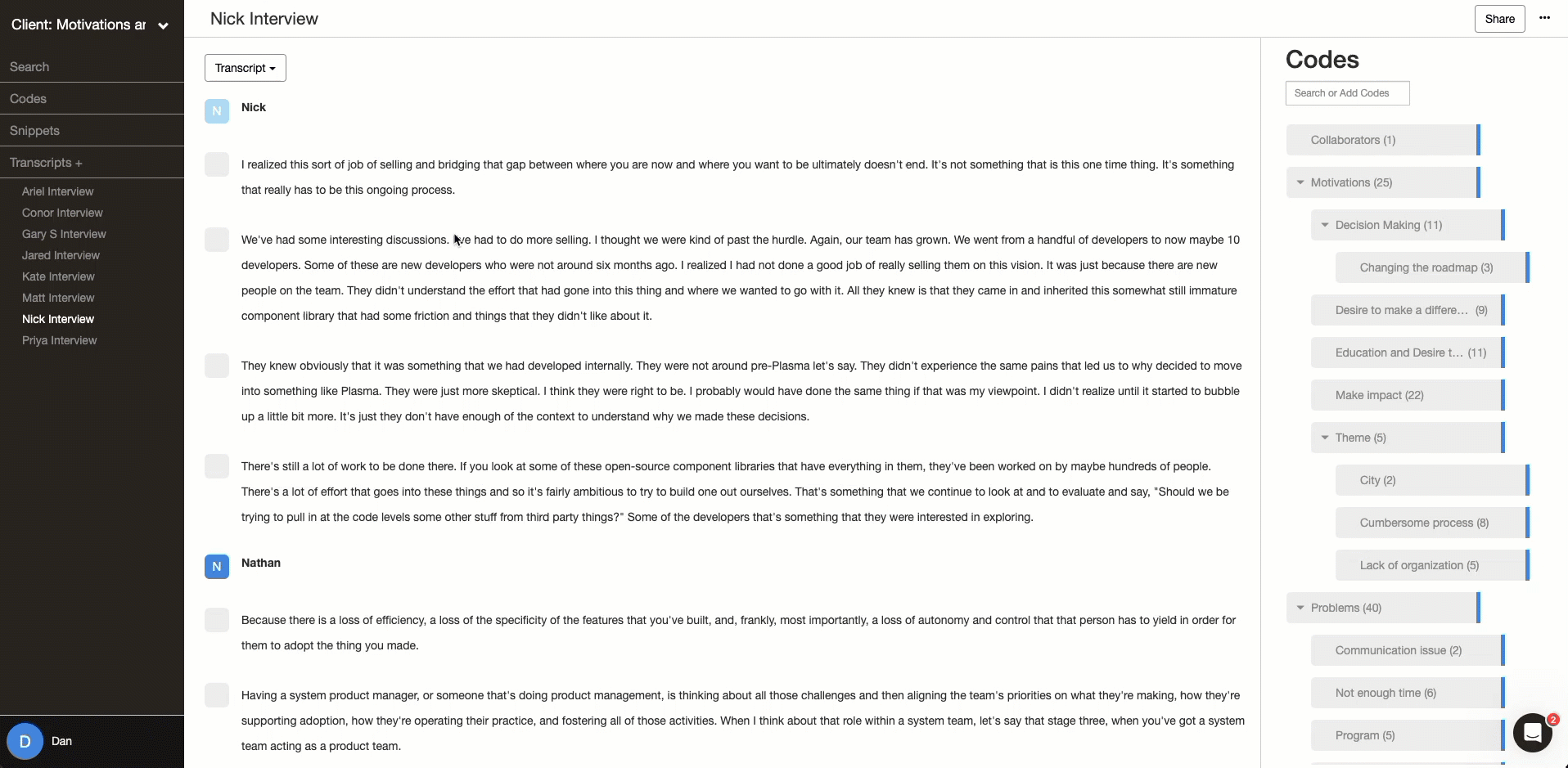What is Holistic Coding in Qualitative Research? A Guide
Holistic coding is a qualitative approach where you assign a single code to a data unit, such as a paragraph, transcript, or entire corpus, to capture its overall meaning. It allows researchers to get a 10,000-foot view of their data by identifying the key themes and concepts.
Saldaña (2012) coined the term, noting the time-saving benefits of capturing “the essence” of large quantitative datasets in the early stages of a study. This article offers an interpretation of Saldaña’s work on holistic coding and a practical guide for applying it to your research.
What is Holistic Coding?
Holistic coding is a first-cycle coding method, the initial stage of coding where the researcher identifies the main themes or concepts in the data, providing a high-level understanding of the data. It sets the stage for more organized second-cycle coding in later stages of research.
For reference, second-cycle coding methods like axial coding, elaborative coding, or descriptive coding are where researchers engage in a more analytical assessment and categorization process.
Holistic coding is also an inductive qualitative method where researchers assign meaning (and generate code) through iterative readings of the data. Holistic codes are like an initial discovery process that helps to unearth new themes or concepts from the data, instead of coding the data based on a preexisting study or theory.
By employing holistic coding, researchers gain a comprehensive understanding of the data they are working with. Like open coding, it provides a broad overview and aids in identifying potential categories or themes that help structure your research.
What Makes a Holistic Code?
Holistic codes can be single words, phrases, or short sentences. Saldaña adds that holistic codes are typically descriptive and do not usually include analytical or interpretive elements. Instead, they capture the “essence of the data unit.”
For example, a holistic code for a paragraph about a participant's experience of grief might be "Loss of a loved one." This code captures the overall meaning of the data unit (a paragraph) in a single phrase. It does not include the participant's thoughts or feelings about the loss.
You want a holistic code to be broad enough to capture various themes and concepts but specific enough to help identify overarching patterns and trends.
When to Use Holistic Coding?
Holistic coding is beneficial when you have a general idea of what to investigate within the data. From that broad starting point, you can familiarize yourself with your data before transitioning to more detailed, second-cycle coding methods (Saldaña, 2012).
Here are some instances where holistic coding can be particularly valuable:
Exploratory Research: Holistic coding is ideal for gaining a broad understanding and identifying potential themes or patterns in inductive, exploratory studies.
Preliminary Data Analysis: Holistic coding is a valuable tool in the early stages of qualitative research, providing an initial overview of the data and forming a foundation for further analysis.
Hypothesis Generation: Holistic coding helps researchers explore and identify potential categories or themes aligned with their research question or hypothesis.
Comparative Analysis: Holistic coding helps identify overarching patterns and themes when conducting comparative analysis across multiple cases or data sources.
Large-Scale Studies: Holistic coding is particularly useful in managing and navigating large amounts of data, such as extensive surveys or multiple interview transcripts.
Benefits and Limitations of Holistic Coding
While holistic coding is a helpful way to familiarize yourself with your data, it tends to lack nuance and detailed analysis. This broad-strokes approach in the first stages of your research sets the stage for more detailed and nuanced analysis in the subsequent steps.
Here are some benefits of using holistic coding:
It can help you to get a sense of the overall meaning of the data.
It can help you identify key themes and concepts in the data.
It can help you to develop a coding scheme for more detailed analysis.
Here are some limitations of using holistic coding:
It can be challenging to capture the nuances of the data with a single code.
It can be tough to compare different data units coded with the same holistic code.
It can be time-consuming to code large data units, even when applying just one code.
Overall, holistic coding provides a broad understanding of data but lacks subtlety.
Possible Applications of Holistic Coding
Holistic codes are helpful because they capture the essence of the data unit in a single code. Here are some examples of how to use holistic coding in qualitative research:
When studying the experience of grief, you could use “Loss” as a holistic coding to identify paragraphs where participants discuss the experience of losing a loved one.
Suppose you want to study the impact of a new educational program. Holistic coding lets you code complete interview transcripts to identify emerging themes and concepts. “Test scores” is a possible holistic code that helps organize your data.
A researcher studying the political views of a group of people might use holistic coding to code entire speeches. The goal is to identify top-level themes across participants. “Political ideology,” “Policy positions,” or “Values and beliefs” would be relevant holistic codes.
Applying Holistic Coding
To apply holistic coding effectively, here are the key steps:
1. Familiarize yourself with the data. Read the entire data set and upload it into a qualitative tool like Delve. Use the tool to record memos on the overall content and context. Consider the research question and how the data might help you to answer it as you read. Tools like Delve’s memo feature make recording, organizing, and storing your initial thoughts and ideas easy.
2. Determine the coding unit. The coding unit is the smallest unit of data that you will code. It can vary depending on the type of data and the research question.
For example, the coding unit could be a single paragraph or an entire transcript if you are coding interview transcripts. If you are coding text documents, the coding unit might be a single sentence, paragraph, or entire source. Smaller coding units require more time and effort upfront but give you a more granular view of the corpus.
💡 using Delve, you can determine the coding unit by highlighting the sentence, paragraph, or multiple paragraphs.
3. Create a holistic code. The code should capture the essence of one of the data's central themes. To do this, you can ask yourself the following questions:
What are the key concepts or themes that are present?
How much detail do I need to capture the meaning of the data?
What do I want to learn from using holistic coding?
How does the holistic code help answer my research question?
4. (Optional) Streamline your coding. Once you develop a holistic code, add the code to your qualitative data tool.
5. Note potential categories. After you’ve created codes, keep track of any potential categories or themes that emerge. You can use Delve to create themes and categories to organize your codes. Then you can also visualize how your codes aggregate, making it easier to categorize emergent patterns and themes in your data.
6. Iterate. Review your codes regularly to continuously refine your understanding of the data. This is an iterative process, so you may need to go back and forth between coding and revising your codes several times. Tools like Delve make it simple to edit, delete, and evolve codes as you go.
Record memos for new categories or emerging themes as you revise your codes.
It is important to be flexible and open to new ideas as you iterate.
This can be time-consuming but helps produce high-quality coding results.
7. Transition to second-cycle coding. Once you have completed the holistic coding phase, you can move on to more detailed coding methods in your second-cycle approach.
This approach gives you an initial sense of the data's overall contents and helps structure your codebook, paving the way for more detailed analysis and interpretation.
Holistic Coding With Delve
Delve’s intuitive, cloud-based coding software helps streamline the time-consuming and tedious parts of holistic coding.
Here are some of Delve’s specific features that streamline the holistic coding process:
Efficient coding: Delve's intuitive interface makes applying holistic codes to your data easy. You can simply drag and drop your data, select the text you want to code, and then assign a code. See how in this video: https://youtu.be/IhQmctWTbbo
Visualization: Delve's code visualization features make it easy to see how your codes aggregate. This can help you to identify patterns and relationships in your data.
Iteration: Delve makes it easy to iterate on your codes. The cloud-based coding tool makes it easy to organize, revise and refine your coding scheme as you learn more about your data.
References
Saldaña, J. (2012). The coding manual for qualitative researchers. 3rd ed. London, England: SAGE Publications.
Cite This Article
Delve, Ho, L., & Limpaecher, A. (2023c, July 16). What is Holistic Coding in Qualitative Analysis? A Guide https://delvetool.com/blog/holistic-coding

